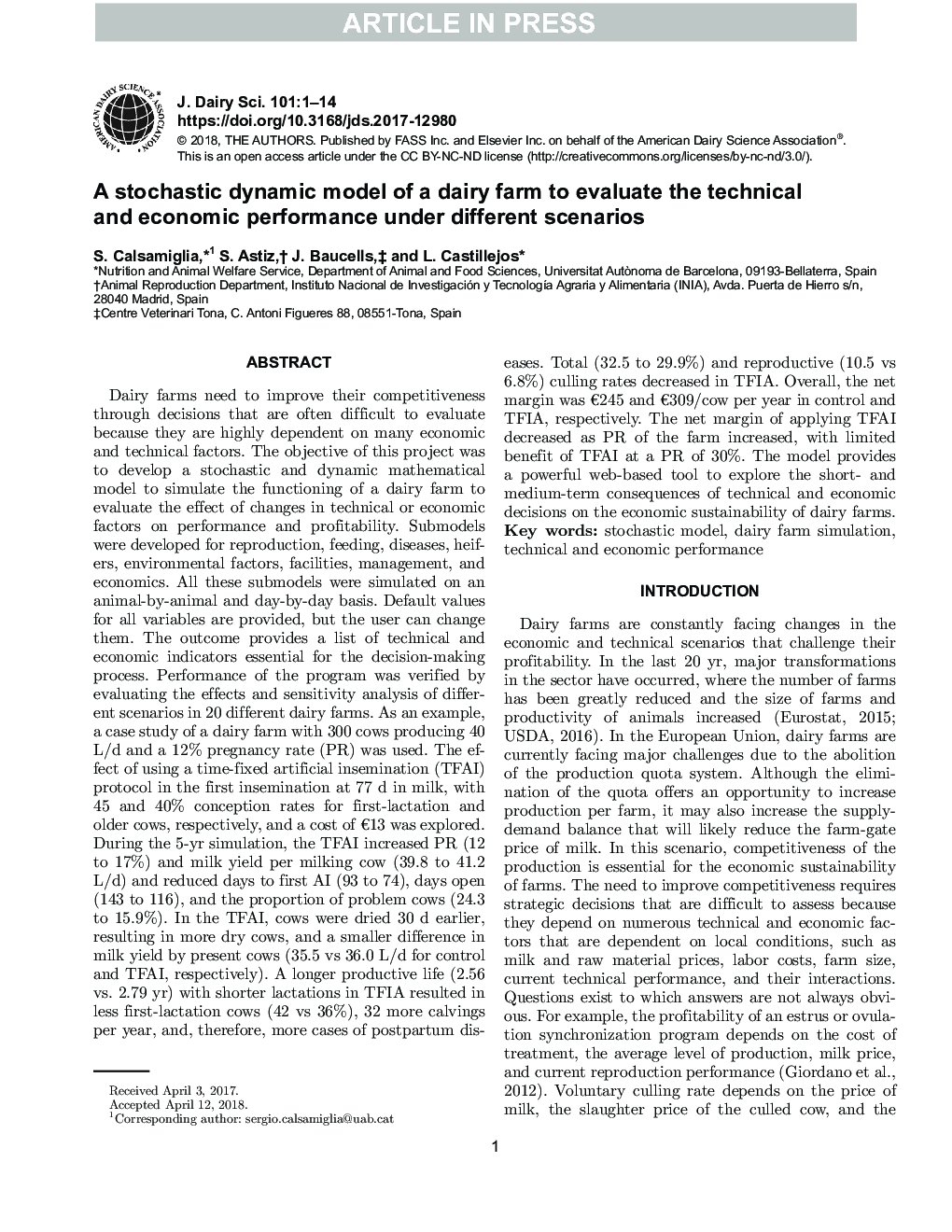| کد مقاله | کد نشریه | سال انتشار | مقاله انگلیسی | نسخه تمام متن |
|---|---|---|---|---|
| 8500967 | 1553837 | 2018 | 14 صفحه PDF | دانلود رایگان |
عنوان انگلیسی مقاله ISI
A stochastic dynamic model of a dairy farm to evaluate the technical and economic performance under different scenarios
ترجمه فارسی عنوان
یک مدل پویایی تصادفی یک مزرعه لبنی برای ارزیابی عملکرد فنی و اقتصادی در شرایط مختلف
دانلود مقاله + سفارش ترجمه
دانلود مقاله ISI انگلیسی
رایگان برای ایرانیان
کلمات کلیدی
مدل تصادفی شبیه سازی مزرعه، عملکرد فنی و اقتصادی،
موضوعات مرتبط
علوم زیستی و بیوفناوری
علوم کشاورزی و بیولوژیک
علوم دامی و جانورشناسی
چکیده انگلیسی
Dairy farms need to improve their competitiveness through decisions that are often difficult to evaluate because they are highly dependent on many economic and technical factors. The objective of this project was to develop a stochastic and dynamic mathematical model to simulate the functioning of a dairy farm to evaluate the effect of changes in technical or economic factors on performance and profitability. Submodels were developed for reproduction, feeding, diseases, heifers, environmental factors, facilities, management, and economics. All these submodels were simulated on an animal-by-animal and day-by-day basis. Default values for all variables are provided, but the user can change them. The outcome provides a list of technical and economic indicators essential for the decision-making process. Performance of the program was verified by evaluating the effects and sensitivity analysis of different scenarios in 20 different dairy farms. As an example, a case study of a dairy farm with 300 cows producing 40 L/d and a 12% pregnancy rate (PR) was used. The effect of using a time-fixed artificial insemination (TFAI) protocol in the first insemination at 77 d in milk, with 45 and 40% conception rates for first-lactation and older cows, respectively, and a cost of â¬13 was explored. During the 5-yr simulation, the TFAI increased PR (12 to 17%) and milk yield per milking cow (39.8 to 41.2 L/d) and reduced days to first AI (93 to 74), days open (143 to 116), and the proportion of problem cows (24.3 to 15.9%). In the TFAI, cows were dried 30 d earlier, resulting in more dry cows, and a smaller difference in milk yield by present cows (35.5 vs 36.0 L/d for control and TFAI, respectively). A longer productive life (2.56 vs. 2.79 yr) with shorter lactations in TFIA resulted in less first-lactation cows (42 vs 36%), 32 more calvings per year, and, therefore, more cases of postpartum diseases. Total (32.5 to 29.9%) and reproductive (10.5 vs 6.8%) culling rates decreased in TFIA. Overall, the net margin was â¬245 and â¬309/cow per year in control and TFIA, respectively. The net margin of applying TFAI decreased as PR of the farm increased, with limited benefit of TFAI at a PR of 30%. The model provides a powerful web-based tool to explore the short- and medium-term consequences of technical and economic decisions on the economic sustainability of dairy farms.
ناشر
Database: Elsevier - ScienceDirect (ساینس دایرکت)
Journal: Journal of Dairy Science - Volume 101, Issue 8, August 2018, Pages 7517-7530
Journal: Journal of Dairy Science - Volume 101, Issue 8, August 2018, Pages 7517-7530
نویسندگان
S. Calsamiglia, S. Astiz, J. Baucells, L. Castillejos,
